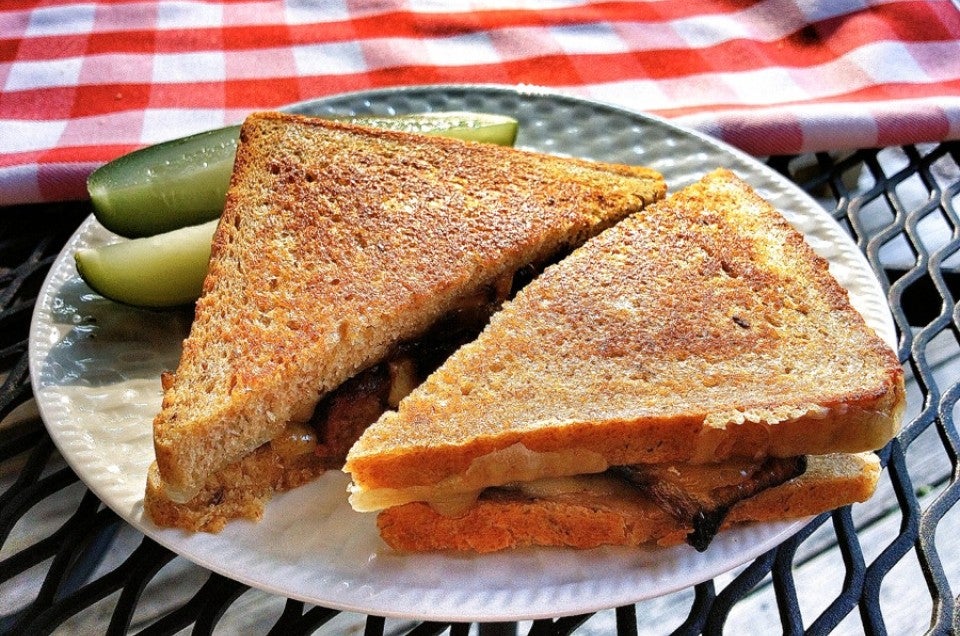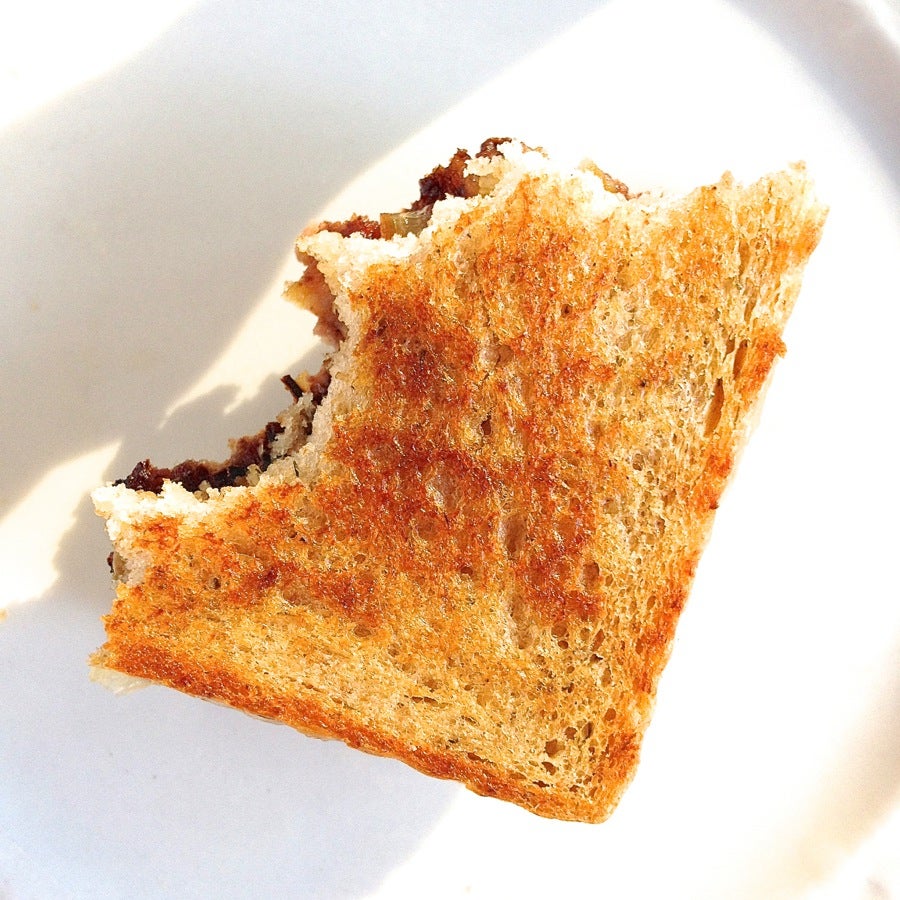


Bake rye bread – in July?
You're kidding.
Baking rye bread has a certain feel to it – a snowing-outside, spend-the-day-in-your-warm-kitchen aura.
Unlike baking, say, bright and sunny English Muffin Toasting Bread, baking rye bread, with its heavy, dark demeanor, feels like a primal experience – like winter itself.
So, why am I baking rye bread in July?
Because speaking of primal, I had a sudden urge for a patty melt.
Inspired perhaps by all those burgers on the grill over the 4th of July, I remembered one of my first "Ah-ha!" food moments: the time I realized "Hmmm, there's a big world of food out there beyond what Mom puts on the table."
Picture a cold, late-fall afternoon. I'm in high school. Field hockey practice over, the sun setting in a brilliant deep-purple and gold sky, the team starts to disperse – the younger girls to the "late bus," the older ones with whoever was lucky enough to nab the family car that morning.
Feeling smug – "We're so cool, we don't take the bus anymore" – we head to Friendly's, the local ice cream/burger chain, for a pre-dinner snack.
Banana split at 5:30 – dinner at 6 p.m.? No problem.
But frankly, much as I love ice cream, it doesn't sound very comforting on this frosty late-fall evening.
How about a hot burger and fries? Just right.
I glance at the menu. There's the regular burger (with cheese, if you want to pay the extra 10¢). But there's also something called a "patty melt" – a burger on sliced grilled rye bread.
Rye bread instead of a hamburger bun? With Swiss cheese, not yellow American? And fried onions to boot? Now THAT'S over the top. Ever the culinary daredevil, I decide to try it.
And am immediately won over. The sweet caramelized onion, nutty melted Swiss, juicy burger, and buttered/grilled rye are the ideal combination of crisp bread, soft cheese, and a range of perfectly matched flavors.
I wolf down my first patty melt – then go home and devour the pork chops and mashed potatoes my mom sets in front of me.
Anyway, enough with the trip down Memory Lane. Even though rye feels like a cold-weather bread, the prospect of patty melts is one very good reason to bake rye in July.
You've got the grill going anyway, right? Once you've baked your rye bread, you're only a few simple steps away from this wonderfully comforting (and all-season) sandwich.
Let's make some patty melts; and while we're at it, I've got five rye/patty melt "tricks" to show you.
We'll start with my favorite Sandwich Rye Bread recipe – but feel free to try the following suggestions with the sandwich rye recipe of your choice.
TRY THIS: Substitute dill pickle juice for half the water in the recipe.
WHY? The signature flavor so many of us identify as rye is usually a combination of other flavors: chiefly caraway, dill, mustard, and a hint of sour. Pickle juice adds a bit of sour and a touch of dill.
Hint: for even more rye taste, try our Deli Rye Flavor.
ADJUSTMENT: If the pickle juice tastes noticeably salty, reduce the salt in your recipe; in the recipe I use, with half-sour pickle juice, I reduce the salt by 1/4 teaspoon.
This will be a "taste and see" proposition for you, with your own recipe and pickle juice; add less salt than you think the dough needs, then more to taste.
TRY THIS: Substitute sourdough starter (fed or unfed) for some of the flour and water in the recipe.
WHY? Because it's a good way to use up that discard sourdough you end up with during the feeding process. And it adds flavor. Plus if you use fed sourdough, it gives the loaf a lift, to boot.
ADJUSTMENT: Since sourdough starter is basically equal parts flour/water by weight, reduce the amount of flour and liquid in your recipe as follows: If you use 8 ounces (1 cup) starter, reduce the flour in your recipe by 1 cup (approx. 4 ounces); and the liquid by 1/2 cup (4 ounces).
Tip: If your starter is liquid enough to be pourable, like heavy cream or pancake batter, don't reduce the flour in your recipe as much.
In this particular recipe, I substitute 6 ounces starter for 3 ounces (3/4 cup) bread flour and 3 ounces water – see how the formula works?
Which flour should you substitute for: rye, or all-purpose/bread? Since sourdough starter is usually made with all-purpose flour, substitute for the AP or bread flour, rather than the rye.
TRY THIS: Knead rye dough in your bread machine, then take it out and bake it in a pan (see next tip).
WHY? Rye dough, with its lower gluten content, can be a challenge to knead. It's inherently sticky. And if you're kneading by hand (or even using a mixer), the tendency is to add more flour – which will make your bread dense and dry.
Instead, throw all the ingredients into the bucket of your bread machine, press start, and check the dough about 10 minutes into the kneading cycle; adjust its consistency with additional flour or liquid, as necessary. And come back in an hour for your effortlessly kneaded and perfectly risen dough.
ADJUSTMENT: None needed. Kneading dough in a bread machine is super-simple.
"Can I bake the bread right in my machine?" Totally depends on your recipe. The only way to find out is to give it a try. That worst that'll happen is you end up with a treat for the birds and squirrels.
Next, consider your pan –
TRY THIS: Bake your rye loaf in a lidded 9" pain de mie pan, instead of a regular 8 1/2" x 4 1/2" or 9" x 5" loaf pan.
WHY? Because the resulting loaf, confined as it rises by the pan's lid, will have a wonderfully dense/close-grained/moist texture.
Think easy "sliceability," perfect for hors d'oeuvres (smoked salmon), toast, and sandwiches.
The loaf will also have square corners – very nice for stacking ham-on-rye sandwiches into plastic containers prior to packing into the picnic basket.
ADJUSTMENT: This pan is a fit for recipes using between 3 and 4 cups of flour.
TRY THIS: When making a patty melt (or grilled cheese, or panini, or any kind of grilled sandwich), spread the outside (the grilling side) of the sliced bread with mayo, instead of butter or oil.
WHY? Mayonnaise gives grilled bread added flavor, and just as much crunch as butter or oil. Plus there's no need to soften or melt mayo; it's wonderfully spreadable right from the jar.
ADJUSTMENT: None needed. Spread mayo on the bread just as you would softened butter.
OK, we've got the bread and cheese.
And the onions, which I sautéed out on my deck, to avoid a grease-spattered kitchen counter.
And the grilled burgers.
Let's build some patty melts!
Assembly is easy.
For two patty melts, spread mayonnaise on one side of each of four slices of rye bread. Layer all four slices with Swiss cheese.
Spread sautéed onions on two of the slices; lay a hamburger patty atop the onions. Top with the remaining bread/cheese – cheese side in, mayo side out.
Sauté over medium heat until the cheese is melted, and the sandwiches are golden brown on both sides.
See how evenly golden brown the crust is? That's the mayo doing its thing.
Enjoy...

...to the last delicious bite!
And THAT, my friends, is the "why" behind rye in July!
Our Sandwich Rye Bread calls for pumpernickel flour; if you'd like to learn more about the differences between various rye options, see our blog post on types of rye flour.